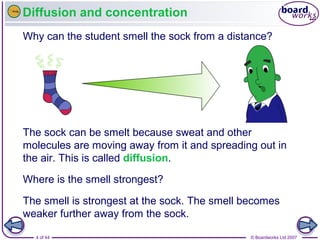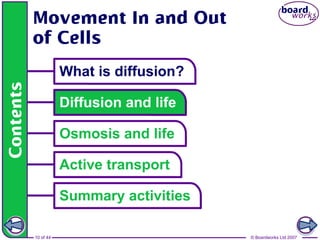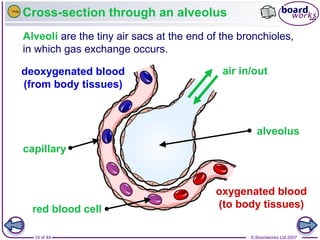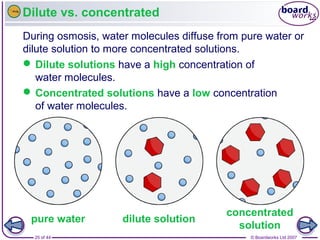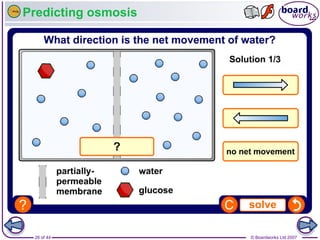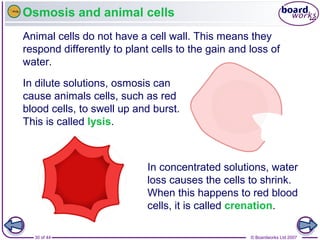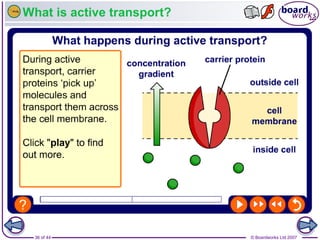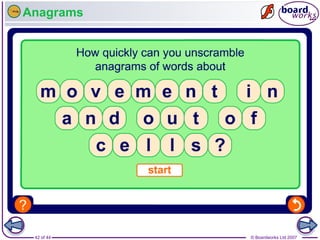Movement in and out of cells
- 1. © Boardworks Ltd 20071 of 44
- 2. © Boardworks Ltd 20072 of 44
- 3. © Boardworks Ltd 20073 of 44 What is diffusion?
- 4. © Boardworks Ltd 20074 of 44 Diffusion and concentration Why can the student smell the sock from a distance? The sock can be smelt because sweat and other molecules are moving away from it and spreading out in the air. This is called diffusion. Where is the smell strongest? The smell is strongest at the sock. The smell becomes weaker further away from the sock.
- 5. © Boardworks Ltd 20075 of 44 Moving molecules In which states are molecules able to diffuse? Molecules in liquids and gases are constantly moving and bumping into each other. This means that they tend to spread out. gas (e.g. steam)liquid (e.g. water)solid (e.g. ice)
- 6. © Boardworks Ltd 20076 of 44 Diffusion in action: one gas
- 7. © Boardworks Ltd 20077 of 44 Diffusion in action: two gases
- 8. © Boardworks Ltd 20078 of 44 Changing concentrations The rate of diffusion depends on several factors, such as the distance the particles have to travel and the difference in concentration. Molecules diffuse until they are evenly spaced apart and equilibrium is reached. During diffusion molecules move from an area of high concentration to an area of low concentration. They are said to move down a concentration gradient. Diffusion is a passive process which means that no energy is needed. high concentration low concentration
- 9. © Boardworks Ltd 20079 of 44 Diffusion: true or false?
- 10. © Boardworks Ltd 200710 of 44
- 11. © Boardworks Ltd 200711 of 44 Why is diffusion important to life? Diffusion is the main way in which substances move over short distances in organisms. What substances need to move? Oxygen, food and waste products are some of the substances that move by diffusion. In animals, how do these vital substances get to where they are needed? The substances are transported in the bloodstream, from where they can diffuse in and out of cells.
- 12. © Boardworks Ltd 200712 of 44 Diffusion and breathing Breathing involves the exchange of gases in the lungs; a process that occurs by diffusion. What happens when you breathe in? Oxygen in inhaled air diffuses through the lungs and into the bloodstream. The oxygen is then transported throughout the body. Carbon dioxide is the waste gas produced by respiration. Carbon dioxide diffuses from body tissues into the bloodstream and is exhaled via the lungs. Where does gas exchange take place in the lungs?
- 13. © Boardworks Ltd 200713 of 44 Structures of the respiratory system
- 14. © Boardworks Ltd 200714 of 44 Cross-section through an alveolus deoxygenated blood (from body tissues) oxygenated blood (to body tissues) air in/out Alveoli are the tiny air sacs at the end of the bronchioles, in which gas exchange occurs. alveolus capillary red blood cell
- 15. © Boardworks Ltd 200715 of 44 How are alveoli adapted? Alveoli have several adaptations that help to make gas exchange very efficient: They are very thin – only one cell thick. They are covered by a network of fine capillaries, enabling gases to pass almost directly between the lungs and bloodstream. They are moist, encouraging gas molecules to easily dissolve. They have a large combined surface area, allowing large amounts of gases to be exchanged with each breath.
- 16. © Boardworks Ltd 200716 of 44 What happens in the alveoli?
- 17. © Boardworks Ltd 200717 of 44 Diffusion and digestion Digestion breaks down large food molecules into smaller molecules such as glucose, amino acids and fatty acids that can be easily absorbed. Carbohydrates, proteins and fats are made up of large molecules that cannot be readily absorbed by the body. In which part of the digestive system is most food absorbed? Small food molecules are usually absorbed in the small intestine, diffusing across the intestine wall and into the bloodstream.
- 18. © Boardworks Ltd 200718 of 44 How is the small intestine adapted? The wall of the small intestine is lined with many tiny finger- like projections called villi. These are very thin and increase the surface area of the small intestine, both of which increase the speed of diffusion. blood vessels capillary network villus small intestine
- 19. © Boardworks Ltd 200719 of 44 Diffusion and the small intestine How does the initial concentration of dissolved food molecules in the small intestine compare with the concentration of the blood in the villi? The concentration of dissolved food molecules is higher in the small intestine than in the blood entering the villus. This means that the dissolved food molecules diffuse from the small intestine into the blood, moving from higher to lower concentration. glucose
- 20. © Boardworks Ltd 200720 of 44 Diffusion and the placenta The placenta is an organ that develops in the uterus of female mammals during pregnancy. The umbilical cord connects the placenta to the fetus. The placenta enables nutrients and oxygen to pass from the mother to the fetus by diffusion, and waste substances to diffuse from the fetus back to the mother. The placenta can filter out certain molecules and bacteria, but is unable to stop many harmful substances such as alcohol, chemicals and some types of virus from reaching the fetus.
- 21. © Boardworks Ltd 200721 of 44 Diffusion and the placenta How does the placenta work? umbilical cord blood to mother low in O2/nutrients, high in CO2/waste umbilical artery umbilical vein placental villi increase surface area for diffusion blood from mother high in O2/nutrients, low in CO2/waste
- 22. © Boardworks Ltd 200722 of 44 Diffusion and nerves impulses nerve impulseneurotransmitter receptor synaptic cleft A synapse is a junction between two neurones across which electrical signals must pass. Neurotransmitter molecules diffuse from vesicles towards the neurotransmitter receptors, moving from an area of high concentration to low concentration. neurotransmitter
- 23. © Boardworks Ltd 200723 of 44
- 24. © Boardworks Ltd 200724 of 44 What is osmosis? water glucose partially- permeable membrane (visking tubing) Osmosis is the diffusion of water molecules from a low concentration solution to high concentration solution, across a partially-permeable membrane. A partially-permeable membrane has holes in it that permit water molecules through but are too small to allow larger molecules through. Osmosis can be demonstrated using visking tubing filled with a solution and placed in a beaker of pure water.
- 25. © Boardworks Ltd 200725 of 44 Dilute vs. concentrated Concentrated solutions have a low concentration of water molecules. Dilute solutions have a high concentration of water molecules. During osmosis, water molecules diffuse from pure water or dilute solution to more concentrated solutions. pure water dilute solution concentrated solution
- 26. © Boardworks Ltd 200726 of 44 Predicting osmosis
- 27. © Boardworks Ltd 200727 of 44 Osmosis in action
- 28. © Boardworks Ltd 200728 of 44 Osmosis and cells Plant and animal cells are surrounded by a partially- permeable plasma membrane. This allows water and other small molecules to diffuse across. plant cell red blood cell cell wall Plant cells additionally have a strong cell wall surrounding the membrane which offers support and protection. plasma membrane
- 29. © Boardworks Ltd 200729 of 44 Osmosis and plant cells
- 30. © Boardworks Ltd 200730 of 44 Osmosis and animal cells Animal cells do not have a cell wall. This means they respond differently to plant cells to the gain and loss of water. In concentrated solutions, water loss causes the cells to shrink. When this happens to red blood cells, it is called crenation. In dilute solutions, osmosis can cause animals cells, such as red blood cells, to swell up and burst. This is called lysis.
- 31. © Boardworks Ltd 200731 of 44 Osmosis and animal cells
- 32. © Boardworks Ltd 200732 of 44 Osmosis and animal cells In order to remain healthy, animal cells need to maintain an isotonic water balance. This means that the water concentration both inside and outside the cell are equal. The concentration of water and salt in the blood are controlled by the kidneys. The kidneys are controlled by the portion of the brain called the hypothalamus. hypothalamus
- 33. © Boardworks Ltd 200733 of 44
- 34. © Boardworks Ltd 200734 of 44 Movement in and out of cells Substances move in and out of cell by passive and active transport. Which methods of transport are illustrated?
- 35. © Boardworks Ltd 200735 of 44 What is active transport? Substances can move passively in and out of cells by diffusion until the concentration on both sides of the cell membrane reaches an equilibrium. Substances can continue to move in and out of a cell using a process called active transport. As the name suggests, active transport requires energy from the cell, which is made available by respiration. During active transport, protein carriers in the cell membrane ‘pick up’ particles and move them against the concentration gradient.
- 36. © Boardworks Ltd 200736 of 44 What is active transport?
- 37. © Boardworks Ltd 200737 of 44 Active transport in plants Plants need to absorb mineral elements such as nitrogen, phosphorus and potassium from the soil for healthy growth. When the concentration of minerals in soil is lower than inside the plant, active transport is used to absorb the minerals against the concentration gradient. What would happen if the plant relied on diffusion to absorb minerals? The cells would become drained of minerals because they would travel down the concentration gradient. minerals
- 38. © Boardworks Ltd 200738 of 44 Active transport in humans During digestion, the villi in the small intestine absorb the soluble nutrients. Over time, the concentration of nutrients in the villi reach an equilibrium with the concentration in the gut. Active transport is used to continue the transport of the small amounts of remaining nutrients against the concentration gradient. glucose
- 39. © Boardworks Ltd 200739 of 44
- 40. © Boardworks Ltd 200740 of 44 Glossary (1/2) active transport – The movement of molecules against a concentration gradient, and which requires energy. alveoli – The tiny air sacs at the end of the bronchioles in which gas exchange takes place in mammals. concentration gradient – The difference in concentration across a given area. crenation – The shrinking of animal cells in response to water loss by osmosis. diffusion – The movement of molecules from an area of high concentration to low concentration. osmosis – The diffusion of water molecules from a dilute solution to a more concentrated solution.
- 41. © Boardworks Ltd 200741 of 44 Glossary (2/2) partially-permeable membrane – A membrane that allows only certain sized molecules to pass through it. placenta – The organ that transports oxygen, nutrients and waste products to and from the developing fetus. turgid – The state caused by high water uptake in plant cells. villi – Tiny finger-like projections on the inner surface of the small intestine, across which nutrients diffuse.
- 42. © Boardworks Ltd 200742 of 44 Anagrams
- 43. © Boardworks Ltd 200743 of 44 Which process?
- 44. © Boardworks Ltd 200744 of 44 Multiple-choice quiz
Editor's Notes
- Teacher notes This activity could be used as a starter exercise to work on diffusion.
- Teacher notes This activity could be used as a starter exercise to work on diffusion.
- Teacher notes This true-or-false activity could be used as a plenary or revision exercise on diffusion, or at the start of the lesson to gauge students’ existing knowledge of the subject matter. Coloured traffic light cards (red = false, yellow = don’t know, green = true) could be used to make this a whole-class exercise.
- Teacher notes This zoom activity could be used to lead students on a step-by-step journey down to the level of the alveoli. It could also be used to review prior knowledge. Students could be asked to say where alveoli are found and then additional questions could be posed to move them up or down the hierarchy towards a more precise understanding of their location.
- Teacher notes Alveoli = plural; alveolus = singular
- Teacher notes This four-stage animation shows how oxygen and carbon dioxide are exchanged in the alveoli. Suitable prompts could include: Start: What is special about the shape of the alveoli and their position to the capillary blood supply? Stage 1: Why is the blood arriving at the lungs deoxygenated? Stage 2: What colour is haemoglobin? Stage 3: Which other substances are produced during respiration? Stage 4: Approximately what percentage (approx). of exhaled air is carbon dioxide? (4%)
- Teacher notes This drag and drop activity provides the opportunity for informal assessment of students’ understanding of osmosis.
- Teacher notes This activity could be used as a starter exercise to work on osmosis.
- Teacher notes This activity could be used to check students’ understanding of the effects of osmosis on plant cells.
- Teacher notes This activity could be used to check students’ understanding of the effects of osmosis on red blood cells.
- Teacher notes See the ‘Homeostasis’ presentation for more information on osmoregulation.
- Teacher notes This illustration contains several discussion points relating to movement in and out of cells, including: Rats escaping from prisonThis section of the illustration represents diffusion. The rats are running from the prison through the gaps in the fence (representing a partially-permeable membrane). The rats are running from an area of high concentration (inside the prison) to an area of low concentration (outside the prison), i.e. along a concentration gradient. Prison guard watering wilted flowers This section of the illustration represents osmosis. The water being sprayed from the hosepipe represents water particles moving from an area of high concentration to an area of low concentration (the parched soil), i.e. along a concentration gradient. Objects being passed through the wire fenceThis section of the illustration represents active transport. The bags represent cellular substances and the fence represents a partially-permeable membrane. The bags are being passed from an area of low concentration (outside the prison) to high concentration (inside the prison), i.e. against a concentration gradient.
- Teacher notes This two-stage animation shows how substances are transported across the cell membrane. Suitable prompts could include: Start: What kind of molecules are transported by active transport? (e.g. sodium and potassium in muscle cells) Stage 1: Which process provides the energy for active transport? (respiration)
- <number> Boardworks GCSE Additional Science: Biology Movement In and Out of Cells
- <number> Boardworks GCSE Additional Science: Biology Movement In and Out of Cells
- <number> Boardworks GCSE Additional Science: Biology Movement In and Out of Cells
- <number> Boardworks GCSE Additional Science: Biology Movement In and Out of Cells Teacher notes This completing sentences activity could be used as a plenary or revision exercise on movement in and out of cells. Students could be asked to write down the missing words in their books and the activity could be concluded by the completion on the IWB.
- <number> Boardworks GCSE Additional Science: Biology Movement In and Out of Cells Teacher notes This multiple-choice quiz could be used as a plenary activity to assess students’ understanding of movement in and out of cells. The questions can be skipped through without answering by clicking “next”. Students could be asked to complete the questions in their books and the activity could be concluded by the completion on the IWB.




